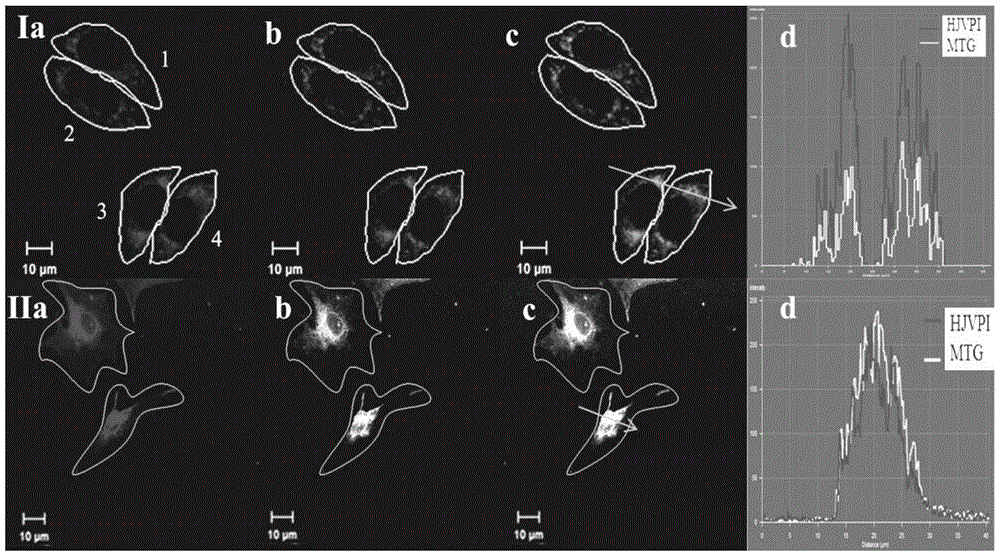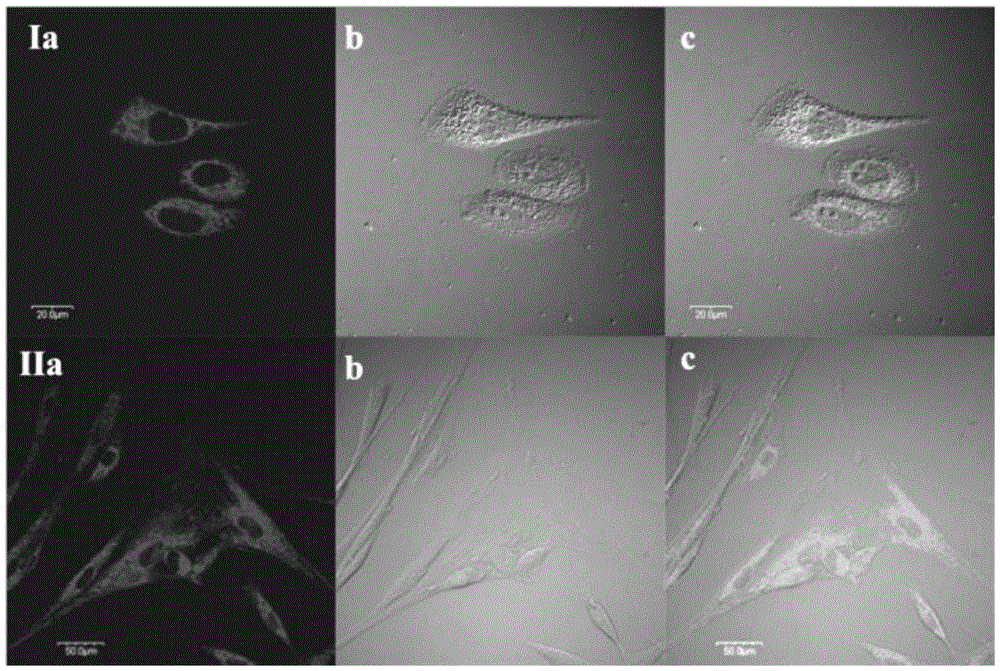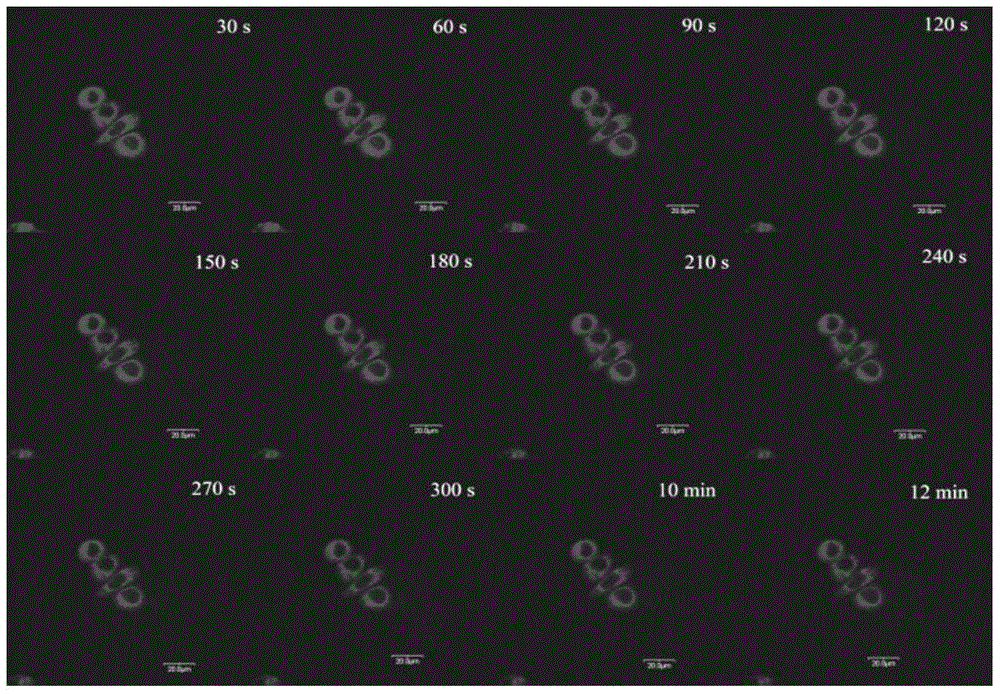A rotor-type double-red mitochondrial fluorescent probe and its application
A technology of fluorescent probes and mitochondria, which is applied in the direction of fluorescence/phosphorescence, luminescent materials, microbial measurement/inspection, etc., can solve the problems that the signal-to-noise ratio of probes needs to be improved, and achieve good application prospects, low excitation energy, and two-photon good performance
- Summary
- Abstract
- Description
- Claims
- Application Information
AI Technical Summary
Problems solved by technology
Method used
Image
Examples
Embodiment 1
[0025] Embodiment 1: the synthesis of HJVPI
[0026]Dissolve 4mmol 8-hydroxyjulonidine-9-carbaldehyde (0.868g) and 4mmol N-methyl-4-methylpyridinium iodide salt (0.94g) in 32mL methanol to obtain a light yellow transparent solution, add 6 drops of piperidine Pyridine, the solution turns red rapidly. Reflux reaction for 8h, cooling, dichloromethane / methanol (20:1) as the eluent, to obtain small purple crystals, namely 4-(2-(8-hydroxy-julolidinyl)vinyl)-1 - picoline iodide salt, yield 15%.
[0027] 1 H NMR (400MHz, DMSO-d 6 ),δ(ppm):8.91(s,1H),8.54(d,J=6.84Hz,2H),8.10(d,J=15.76Hz,1H),7.87(d,J=6.88Hz,2H), 7.19(s,1H),6.96(d,J=15.76Hz,1H),4.11(s,3H),3.24-3.18(m,4H),2.65-2.57(m,4H),1.84(s,4H) . 13 C NMR (100MHz, DMSO-d 6 ), δ (ppm): 154.3, 154.2, 147.0, 144.2, 137.9, 125.4, 121.5, 115.0, 114.9, 111.1, 107.5, 49.9, 49.2, 46.4, 27.3, 21.91, 21.5, 21.0. HRMS (m / z) calcd for C 20 h 23 IN 2 O: 434.31; found, 307.1821 (M-I) + .
Embodiment 2
[0028] Example 2: Culture of immortalized cells (SiHa and HeLa) and normal cells (HUVEC, BMSC and MC3T3-E1)
[0029] SiHa, HeLa, HUVEC, BMSC and MC3T3-E1 cell lines were kept at 37°C, 5% CO 2 cultured in a saturated humidity incubator. SiHa and HeLa cell lines were cultured adherently in H-DMEM medium containing 10% fetal bovine serum (containing 1% double antibody). HUVEC cell lines were cultured adherently in M199 medium containing 10% fetal bovine serum (containing 2 ng / mL FGF-2). BMSC cell lines were cultured adherently in L-DMEM medium containing 10% fetal bovine serum (containing 2 ng / mL FGF-2). The MC3T3-E1 cell line was cultured adherently in αMEM medium containing 10% fetal bovine serum. After the cells grow to the logarithmic phase, culture the slices: ① Soak the coverslips in absolute ethanol for 30 minutes, dry them with an alcohol lamp, and place them in a disposable 35mm culture dish; ② Wash the cells in the 100mL cell bottle with PBS. Three times, digest wit...
Embodiment 3
[0030] Example 3: HJVPI staining of SiHa cells / BMSC cells and MTG counterstaining experiments
[0031] Wash the inoculated cell slide three times with PBS, stain the cells with 2 μM HJVPI, and store in CO 2 30min in the incubator. Aspirate the culture medium and wash it three times with PBS to wash off the unbound excess dye, stain the cells with 0.2 μM MTG, and store in CO 2 30min in the incubator. Then take out the stained cell slides, wash off the unbound excess dye solution, cover the cell growth side down on the glass slide, and observe the stained parts, fluorescence distribution and brightness changes of the cells under a laser scanning confocal fluorescence microscope. It was found that MTG and HJVPI had similar intracellular distribution regions, and the calculated average colocalization rate of 4 SiHa cells was 0.91, and the average colocalization rate of 2 BMSC cells was 0.89. Therefore, it is confirmed that the probe HJVPI of the present invention can specifical...
PUM
 Login to View More
Login to View More Abstract
Description
Claims
Application Information
 Login to View More
Login to View More - R&D
- Intellectual Property
- Life Sciences
- Materials
- Tech Scout
- Unparalleled Data Quality
- Higher Quality Content
- 60% Fewer Hallucinations
Browse by: Latest US Patents, China's latest patents, Technical Efficacy Thesaurus, Application Domain, Technology Topic, Popular Technical Reports.
© 2025 PatSnap. All rights reserved.Legal|Privacy policy|Modern Slavery Act Transparency Statement|Sitemap|About US| Contact US: help@patsnap.com



